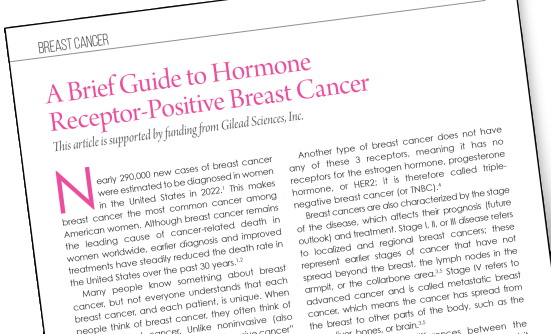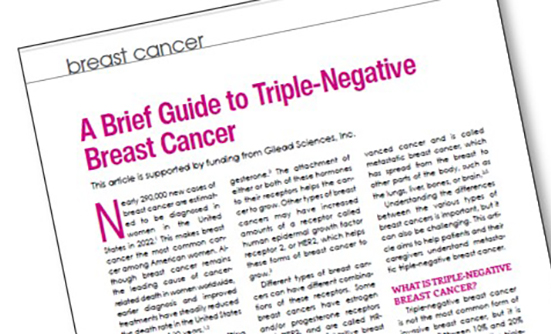You have had a breast biopsy, held your breath waiting for the results, and received a call informing you that you have breast cancer. In that moment, time stands still as you hear words like invasive ductal carcinoma or lobular carcinoma, grade, ER, PR, and HER2-neu. In the next moments, you realize you did not hear anything after hearing the big “C” word—CANCER. An Internet search for the words “breast cancer” has 18,200,000 results. How do you make sense of all the information when it sounds like alphabet soup? What does it all mean? How do you know what applies to your diagnosis? It is like dumping a thousand-piece puzzle out on the table and you have no idea what the picture looks like.
Sorting Out the Basics
A pathologist views the tissue from the biopsy under a microscope to determine the diagnosis. The 2 most common types of breast cancer are ductal and lobular. Ductal cancer starts in the breast ducts, and lobular cancer starts in the lobules. Ductal cancer can be either noninvasive or invasive. The word “invasive” sounds ominous, but it does not necessarily mean the cancer has spread elsewhere in the body. It means the cancer has grown outside the duct or lobule into the surrounding breast tissue and has the potential to spread to other parts of the body. Invasive ductal carcinoma is the most common type of breast cancer. Ductal carcinoma in situ is noninvasive, meaning the cancer cells are inside the ducts. Lobular cancer is invasive only. Lobular carcinoma in situ (LCIS) is not cancer but an uncommon condition in which abnormal cells form in the lobules or milk glands of the breast. LCIS means there is an increased risk of developing a future breast cancer.
A pathologist determines the grade based on a scale rating the appearance of the cells. A scale of 1 to 3 rates how different the cancer cells look from healthy breast cells. In general, grade 1 breast cancer is the least aggressive and grade 3 is the most aggressive. Additional ways of describing grades are as follows:
- Grade 1 = well differentiated or low grade
- Grade 2 = moderately differentiated or moderate grade
- Grade 3 = poorly differentiated or high grade.
What Are Biomarkers?
You wonder why your neighbor with breast cancer only takes a daily oral medication while your oncologist recommends chemotherapy for you. At a molecular level, breast cancer is a diverse disease. In other words, not all breast cancers are created equal. Biomarkers give important details about the biological makeup of the cancer cells. They enable the medical oncologist to personalize treatment, making it more effective.
All breast cancers are tested for estrogen receptors (ERs) and progesterone receptors (PRs). Invasive breast cancers are tested for HER2-neu, often referred to as HER2. The medical oncologist makes treatment decisions based on whether these are positive or negative. If the ERs and PRs are present, it means the cancer is dependent on estrogen and progesterone for survival. It is as though ears on the cancer cells listen to signals from these female hormones telling them to divide and grow. Breast cancers with these receptors are ER/PR positive. The good news is that ER/PR-positive breast cancers can be treated with oral hormone-blocking medications such as tamoxifen (a selective estrogen reuptake inhibitor, or SERM) or an aromatase inhibitor (AI). Examples of AIs are letrozole, arimidex, and exemestane. These medications block estrogen and progesterone, making less estrogen available to stimulate the growth of the cancer. Depriving the hormone-dependent cancer cells of hormones causes them to die.
HER2 is another breast cancer biomarker. HER2 is a protein that promotes growth in cancer cells. HER2 signals normal cell growth by telling the cell to divide and multiply. Cancers with too many copies of the HER2 protein are HER2 positive. About 20% to 25% of breast cancers are HER2 positive. Immunohistochemistry is a lab test that determines the HER2 status. Results of 0 or 1+ are HER2 negative, and results of 3+ are HER2 positive.
HER2 results showing 2+ are equivocal, or borderline. Fluorescent in situ hybridization (FISH) is an additional lab test performed to determine HER2 status. FISH results are “amplified” (positive) or “nonamplified” (negative). In the event the FISH result is borderline, additional molecular tests can help sort out the HER2 status. It is important to determine the HER2 status because the results determine important clinical decisions.
Completing all these biomarker tests can take several additional days. The results are very important in determining a personalized treatment plan that will be effective against your cancer. Waiting for all the results to be complete can feel painstakingly slow and create anxiety and worry.
What Are Targeted Therapies?
Targeted therapies are relatively new in cancer treatment. Traditional chemotherapies destroy cancer cells along with healthy cells. Targeted therapies are like smart bombs, directing treatment at a specific target to destroy it. This results in fewer side effects than traditional chemotherapies. Targeted therapies take aim at a specific molecular feature of a cancer, disrupting the ability of cancer cells to grow, divide, repair, and communicate with other cells.
Several targeted therapies are now available to treat HER2-positive cancers. The 2 most common are trastuzumab and pertuzumab.
Trastuzumab is a monoclonal antibody that works by targeting cancer cells with too many HER2 receptors. Pertuzumab is often given with trastuzumab to provide a more complete blockage of HER2. It is also a monoclonal antibody but attaches to a different area of the HER2 protein, interfering with HER2.
What If the Biomarkers Are Negative?
Triple-negative breast cancer (TNBC) is ER negative, PR negative, and HER2 negative. The absence of hormone receptors and the HER2 protein means there are no specific targets for SERMs, AIs, or targeted therapies. TNBC is more aggressive and more difficult to treat. Traditional chemotherapies are given intravenously to destroy the fast-growing cells.
PD-L1 is another important biomarker that may impact the treatment of TNBC. Cancer immunotherapies are expanding treatment options for many types of cancers. They are designed to use the body’s immune system to fight cancer cells. PD-L1 is a protein that helps cancer cells hide from the immune system and survive. Historically, immunotherapy has not proved to be very effective in treating breast cancer. New research has shown an anti–PD-L1 antibody may be effective in treating TNBC. This is accomplished by awakening the immune system to attack cancer cells by blocking the PD-L1 signal..
Metastatic Breast Cancer
Metastatic breast cancer is breast cancer that has spread to other areas of the body, such as bone, lung, brain, or liver. Diagnosis of metastatic breast cancer can be made at the initial diagnosis or develop months or years later. A biopsy of the suspected metastatic disease is important to confirm the diagnosis and to discover if the biomarkers have changed since the original diagnosis.
Metastatic disease, while not curable, may be treated effectively for months or years beyond the diagnosis with the many options available today. In addition, research is providing more answers and treatments for metastatic breast cancer.
Genomic sequencing is able to map and sequence the DNA and analyze the specific changes driving the cancer. Genomic sequencing provides detailed information as to which targeted therapies or immunotherapies would be effective against the cancer. Clinical trials may also be available based on genomic results.
Genomic sequencing personalizes cancer treatment through the identification of biomarkers. It is the key to unlocking more effective treatments with fewer side effects.
Tips from a Nurse Navigator
- Find a breast center or imaging center that has a nurse navigator
- Ask to meet the nurse navigator
- Go about your regular routines while waiting for results
- Ask to meet with your nurse navigator if you learn you have breast cancer. She will educate you about your diagnosis, answer your questions, and guide you through the complex medical system
- Search reputable websites for information. Blogs often contain inaccurate information, and it can be difficult to know what applies to your specific situation
- If you have metastatic breast cancer, look for a cancer center that participates in clinical trials
- Ask for a biopsy of the metastatic site to learn if the tumor markers have changed from the initial diagnosis
- Request genomic sequencing to learn if there are other treatments or clinical trials that may be available for your treatment.
Patient Resources
Breast Cancer
www.breastcancer.org
Living Beyond Breast Cancer
www.lbbc.org
American Cancer Society
www.cancer.org
National Comprehensive Cancer Network Patient and Caregiver Resources
www.nccn.org/patients
ClinicalTrials.gov
www.clinicaltrials.gov
National Cancer Institute
www.cancer.gov/types/metastatic-cancer
National Breast Cancer Foundation, Inc.
www.nationalbreastcancer.org
















